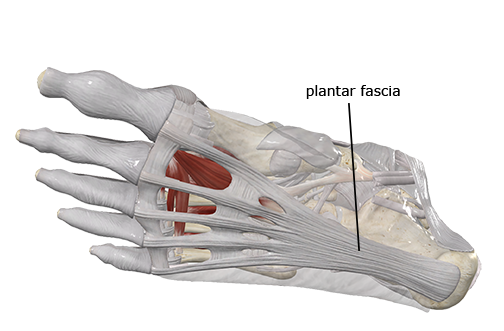What is it plantar fasciitis?
Plantar fasciitis translates to inflammation of the connective tissue (fascia) of the foot. This tissue spans from the calcaneus (heel bone) to the metatarsals (base of the toes) and serves as shock absorption for the lower extremity. When the muscles of the feet become hypotonic (underdeveloped), the fascia also suffers, leading to dysfunction and severe pain throughout the foot. In a similar vein, inflammation can occur if the musculature of the foot becomes hypertonic (overused), causing excessive tension against the attachment points of the plantar fascia.
What causes plantar fasciitis?
PF occurs in cases where the foot becomes imbalanced, altering the force against different sections of our foot-ankle complex. Over-pronation (ankles rotating towards the midline) or hyperextension of the toes are common examples. Many factors can contribute to creating such imbalances: repetitive strain of the calf muscles, sudden changes in activity level, significant weight gain (especially in a short period), or improper footwear (shoes with an elevated heel, narrow toe-box, high arch support, inflexible soles, or restrict ankle/foot mobility in any way) to name a few.
How to mitigate Plantar Fascitis?
Healthy feet are critical to a properly functioning body. If your feet are under/overdeveloped, your gait will be affected, leading to a plethora of other issues throughout the body. For example, studies have shown that people with chronic neck tension often also have dysfunction of the feet. When your feet aren’t properly aligned, it can cause your body weight to shift unevenly, leading to a slouched posture that strains your neck muscles.
Building and maintaining strength and flexibility in the feet and calves is the best way to mitigate PF. Often, podiatrists will prescribe orthotics to help people experiencing severe PF manage their pain. Although this can temporarily bring relief, it does not necessarily solve the underlying imbalances. Orthotics are a temporary crutch which can allow someone in intense pain the breathing room to stretch and strengthen the feet for lasting results.
One of the easiest ways to build healthy foot posture and habits is slowly transitioning into barefoot shoes (no, not the Vibram toe shoes!). Our feet are meant to move with the terrain beneath us – our toes stretch out and grip the ground as we walk. This natural movement cannot occur inside narrow, restrictive footwear. Although performance footwear has become trendy and ubiquitous for everyday people, your average person is generally doing more harm than good using these shoes as streetwear. A pumped up heel shifts your body weight forward, causing your posterior chain to do extra work just to keep you standing straight. High ankle/calf boots restrict the natural range of the calf muscles, leading to additional strain caused to the glutes and hip flexors to compensate.
Our approach to PF treatment:
At Massage Therapy of Boston, we always take a holistic, clinical approach to treating our clients needs. Our therapists will often start by assessing restrictions throughout the lower extremity – performing active and/or passive stretches to the feet, calves, shins, quads, hamstrings, and hips. Myofascial techniques alongside traditional deep massage strokes are utilized to offer relief and improve mobility. Treatment doesn’t end in the office! We will give you our suggestions for exercises and stretches to continue your healing at home between sessions. Plantar fascitis unfortunately does not heal overnight. Though treatment will take time, you can trust that our therapists will work with you to create a treatment plan to get you back on your feet as soon as possible!

